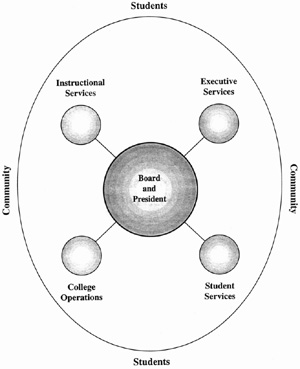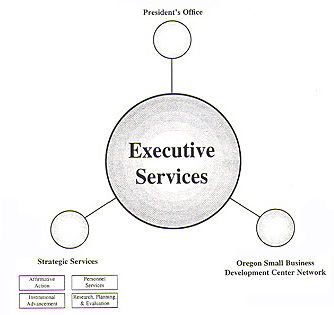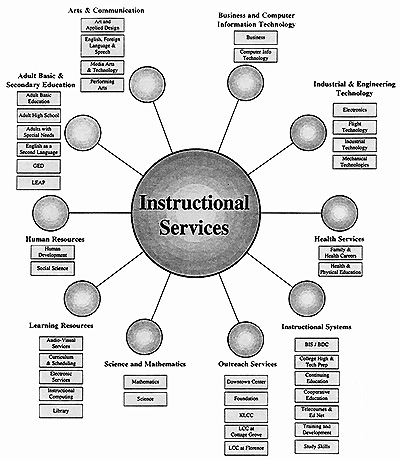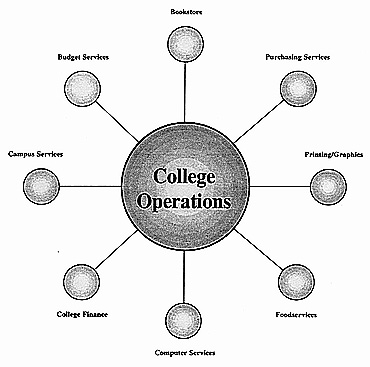| Lane Home Page | Search Lane |
| Website Accessibility |

Restructuring DocumentThe Need for Restructuring In Reframing Organizations (Jossey-Bass, 1991), Bolman and Deal note that organizations tend to resist major restructuring as long as possible. But if institutional circumstances change and the organizational structure does not, pressures build that cannot be ignored. The pressures may be caused by changes in the environment, technology, political climate, or leadership, or by continued growth of the organization. All of these changes have occurred at Lane Community College since the last major restructuring. The Environment At the federal level, policies are now being considered that may provide significant funding for welfare reform and displaced timber workers, and major changes have occurred in federal regulation for financial aid and services to the disabled. On the state level, the passage of Measure 5, combined with the failure of Measure 1, has resulted in a bleak funding outlook for the general operations of Oregon community colleges. Lane faces increasing demands for its services at the same time that resources are declining. There are environmental pressures moving the college toward increased cooperation with high schools (education reform) and workforce agencies (the Workforce Quality Council). Our students will find themselves in rapidly changing environments. The long-term projection is that 90 percent of all jobs will be in knowledge-dependent services, requiring workers with enhanced communication, teamwork, interpersonal and leadership skills. Technology With their emphasis on technical education and training, community colleges are among the most sensitive of educational institutions to changes in technology. Since the last restructuring at Lane, the 'electronics revolution' has occurred in the automobile, heavy equipment and aviation industries; computer-assisted design and manufacturing have transformed industry; and new technologies generally threaten to outstrip the college's ability to keep up in such fields as health, business and communications. Internally, the college has moved to a new software system for administrative applications, with attendant change and disruption. Computers and other forms of advanced technology will play a central role in students' future personal and professional lives. Students who enter Lane have increasingly sophisticated computer skills and expect to have access to the latest computer technology . The Political Climate Prior to the passage of Measure 5, the college was dependent primarily on the local voter for resources. Increasingly, the college must look to state and federal sources for funding, and must secure expanded non-public support. With the shift in funding sources, there is a shift in control from primarily local to primarily state and federal. The state political climate is much more important to Lane now than it was even a few years ago. If the federal government is able to move funding away form defense into education, then the federal government's influence on education is likely also to increase. College Leadership The current Lane president took office in March, 1990 and since that time there has been a complete turnover in leadership at the vice-president level. Only one board member has been in office more than five years. At the same time, the college is trying to move toward shared decision making and shared leadership. Growth Lane reached its highest enrollment ever last year. Beyond the obvious increases in student enrollment, there are shifts in enrollment from primarily full-time to primarily part-time; from younger to older students; and from non-credit to credit, especially transfer. The classified staff is still growing, while contracted faculty and management numbers are more stable. Increasing student demands for classes, together with a lack of stable funding to support new full-time positions, has led to a rapid increase in the number of part-time faculty. Lane must change to accommodate and adapt to the challenges noted above. To continue to be a strong, effective community college, Lane must rethink nearly everything it does, and every staff member will need to consider how to perform his/her job in new ways that are more efficient and effective. Some Caveats The new structure should maintain the strengths of the institution, and should not, if at all possible, create new problems. Lane has many strengths, among them the following:
Restructuring can accelerate our progress, but it cannot solve all, or even most, of our challenges. Restructuring--changing who reports to whom--has a profound effect in bureaucracies. in the new, more flexible, less bureaucratic organization that Lane must become, restructuring is only the first step toward re-engineering our processes, renewing our work relationships, and refocusing our energies. We must learn to work together better. A Vision of the Future Lane Community College provides a quality learning experience in a caring environment. Each of the words in this simple statement is carefully chosen. A community College is meant to be more than a loose assemblage of people either working at or attending a single institution. It is a body of people having common interests and common principles. The common interests are quality and learning; the common principals are the Unifying Principles that appear on posters through the buildings. Lane endeavors to :
Provide quality learning experiences Commit to excellence Promote a sense of achievement Communicate openly Manage with goals Connect with our community and Develop a sense of community ownership Lane is centered on learning and will assume new responsibilities only when they involve learning. Not all learning occurs in the classroom or lab, but can take place through KLCC, a public radio station in the Lane Community College districts, or Elderhostel or a number of other non-classroom activities. Most learning will occur through either education or training. Everyone at Lane--students, staff, etc.--must be engaged in learning. The organization must be a learning organization, 'an organization that is continually expanding its capacity to create its future' (Peter M. Senge, The Fifth Discipline). The widespread interest in total quality, continuous quality improvement, and re-engineering is bases on the idea that quality need not cost more. it can, in fact, cost less if people work in teams to streamline and improve processes. A high quality leaning experience can only be provided by a college devoted to service that meets the needs of customers, both external (students and other beneficiaries) and internal (staff are each other's customers). We will achieve high quality service by focusing on customer needs and desires as measured through research and evaluation, and by focusing on customer needs and desires as measured through research and evaluation, and by strengthening the many processes that compose Lane (admissions, scheduling, curriculum development, etc.). Learning experiences will be evaluated by measuring student outcomes. Lane is to be caring community. People have an absolute need for connections with others, for support systems, for social bonding. A caring community meets this need and actively opposes isolation, fragmentation and divisions among people. in a caring community, faculty, managers, classified staff, and students care about each other and work as a team to strengthen learning on campus. Organizational restructuring is only the beginning of change at Lane. The vision outlined here requires changes in fundamental values, changes in the way we work and in our work relationships, and training for all employees. Fulfillment of this vision is a long-term project to which we must dedicate ourselves for years to come. Success in this venture will depend on our combined commitment to intensive on-going staff training; examining our internal policies and procedures, changing those that hinder service to students; and changing our reword systems to encourage behaviors that support the values of teamwork, quality and service. Characteristics of the New Organization What will be the nature of the new Lane, the Lane of the future? Many have shared their ideas, most of which are incorporated here.
We must change our attitudes towards rules and procedures: rules should be de-emphasized in favor of a single vision to guide our work. Rules and procedures must all be evaluated on the basis of certain decisions and actions must be held accountable for following institutional strategies as well as maintaining compliance with externally-imposed rules and regulations. Administrative support areas must act as enablers in these processes. Finally, we must evaluate performance on the basis of outcomes and results; everyone must be held accountable for accomplishing our mission and goals. Criteria for Restructuring The proposed restructuring should be measured against the following
criteria. Does the change....
2. Improve service by 4. Enable employees involved in a particular work process to work as a team? 5. Improve decision making by ensuring broad and appropriate input? 6. Balance workloads fairly and appropriately? 7. Enhance efficiency and/or effectiveness (streamline)? 8. Enhance flexibility and responsiveness to the community? 9. Support a strategic long-term direction?
2. Incurs a cost greater than its benefit. 3. Makes processes more difficult for students and staff. 4. Could not be explained clearly in the local media. After May 17, 1994 there will be no more administrative 'branches" in the current sense, because the tree metaphor suggests a bureaucracy with secondary parts growing from a main part. It is difficult to develop a new style of organization while using old terms and thinking in old ways. The proposal is to divide Lane into four groups or dynamic assemblages of similar teams. The four groups are: Instructional Services Group, College Operations Groups, Executive Services Group and Student/Learner Services Group. Within the groups, similar departments are grouped together into clusters (e.g. Arts and Communication, Enrollment Services) so that the public and Lane staff will have clearer access to services, and so that areas of duplication can be addressed. While the departments in the clusters will retain their identities, they will be encouraged to become part of a new, larger whole. Categories that now divide us (credit vs. non-credit, transfer vs. professional-tech, etc.) will be de-emphasized in favor of greater collaboration and flexibility. We will work toward developing values and rewards for collaboration and common goals among disciplines, departments and support functions. Shared planning among and within cluster groups will become the norm and will result in 'shared agendas' that will provide enhanced learning opportunities, customer service and quality to our students and community. Instructional Services Groups Roughly equivalent to a combination of what was formerly instruction and Community and Economic Development, this group exists to provide quality learning experiences. Because it is a large group, it will be lead by two vice presidents who will work together as a two-person team, dividing up their responsibilities themselves with advice from others throughout the organization. They will facilitate teaching and learning through ten clusters, six of which are based on the Endorsement Areas (the CAM strands) adopted by the State Board of Education. The departments listed within the ten clusters will maintain their identities and current leadership. However, as department-head positions become vacant through retirement or attrition, the college will explore combining disciplines or will move, where practicable, towards true team leaders and lead faculty. For now, the clusters will meet as teams on a regular basis, plan together and propose team budgets. College Operations Group Based on the current Administrative Services branch, the COG will add several services from other branches and will be lead by a vice president. The group exists to provide quality services to staff and to ensure as caring environment. Executive Services Group Based on the current President's Office, Executive Services will lead and facilitate the new structure. Student Services Group Based on the current Student Services branch, Students Services exists to provide quality services to learners and to ensure a caring environment. It consists of three clusters. Strategic Teams Members of the aforementioned groups and clusters will hold parallel responsibilities in matrix teams (cross functional, vertically integrated teams in which members will pool their efforts in support of key, ongoing institutional directions). The teams and their changes are listed below:
International Education--enables teachers and learners to participate in a global society Legislative Action--ensures that Lane maintains an active an effective effort to inform key external decision-makers of the college's needs Marketing Council--focuses on improving access to the college through the two-way flow of information between the college and its community and customers Staff and Organizational Development--ensures that employees have the skills necessary to succeed in their work environment Transitions--supports internal groups and individuals in transition as a result of institutional changes Future Faculty--develops a vision and plan for Lane's faculty of the future Resource Development--supports and facilitates efforts to obtain and administer grants, contracts and gifts that support the college's mission
Diversity--ensures that the college supports ethnic and social diversity
Quality improvement--monitors the quality of instruction and services and coordinates quality-improvement projects (includes accreditation activities) Quick Response--ensures that Lane works closely and effectively with area workforce agencies in support of Oregon's workforce goals Project teams will be formed on an ad hoc basis to address specific organizational matters: service problems, service enhancements, new directions, etc. They may be formed by the president, by matrix teams, by other project teams, by governance groups or by clusters or work groups. They will be given a specific task and a deadline. Often they will address whole work processes in an effort to improve them. Governance Groups A move toward teams and empowering teams is a natural extension of Lane's philosophy of shared decision making. The formation of cluster teams, strategic (matrix) teams and project teams expands shared decision-making into administrative areas of the college. As empowered teams become the norm, Lane will need to reexamine its governance structure. For now, no change is proposed in the governance groups (College Council, Faculty Council, Classified Council, etc.) College Council will retain its role as the major planning body for the college and as the primary group for formulating and recommending college policy to the president. Faculty and Classified councils and ASLCC will continue to focus on issues and activities of importance to their constituents. Timelines and Plans Plans will be developed for orientation and organizational development activities, and job descriptions for managers will be revised to support the new structure./ Organizational development activities will focus on:
The Lane of the past was a highly successful organization, thanks to strong community support and the hard work of its employees. There is evidence that in the future not only the hard work but also a different kind of work will be necessary for success. The college must change to adapt to a new and highly dynamic environment. It is often the most successful organizations--in the 1960s General Motors, IBM, Exxon, etc.--that are slowest to change when change is needed. Lane must not make that mistake. The most important characteristic of the Lane of the future must be quality. In the past, quality was achieved by hard work and by pouring more resources into a problem or effort. In the future, quality cannot be a function of resources: we must learn to use re-engineering and continuous quality improvement to achieve higher quality at lower cost. We must examine each of our processes to ensure that they are meeting learners' needs. We must work as efficiently as possible. The Lane of the past had many qualities of a bureaucracy. The Lane of the future must instead be a high performance work system. In place of bureaucratic rules we must establish guiding visions: no more rules should be specified than are absolutely necessary. Whenever we encounter variations from the ideal, we must review the total process to improve it (not establish new rules). Employees will need to be more flexible and adaptive and learn to work in teams. To support these teams, information must be even more accessible: data must be shared, and employees must become even more accountable and the college will continue to strengthen its accountability to its local board of education, state-level agencies, and the legislature. The most important activities at Lane are teaching and learning. All of us maintain this central focus, and ensure that we provide quality learning experiences. Above all, we must care--about quality instruction, about Lane, about learners, about each other. An institution that provides quality leaning experiences in a caring environment has nothing to fear from the future.





|
>> Return to Lane's Home Page >> Return to Process Redesign Project Main Page >> Return to top of page Lane Community College - Process Redesign Project 4000 East 30th Avenue, Eugene, OR 97405 Please direct comments about this site to webmaster@lanecc.edu Revised 12/2/96 (llb) © 1996-present Lane Community College |
